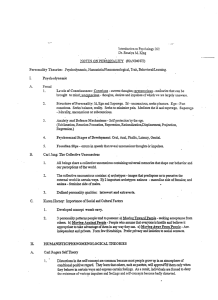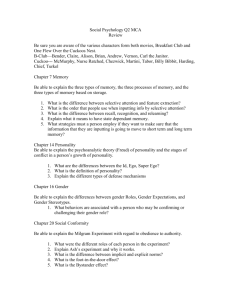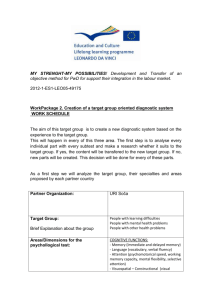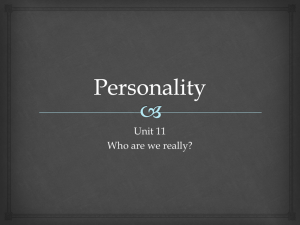Psychology Unit 4 study guide
advertisement
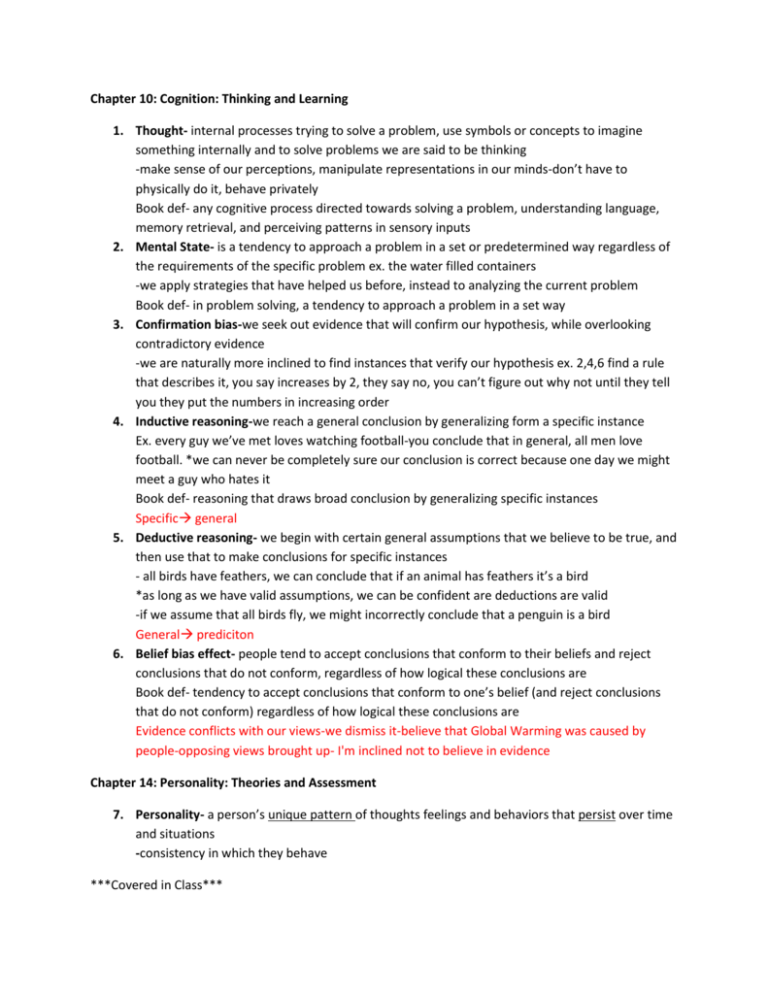
Chapter 10: Cognition: Thinking and Learning 1. Thought- internal processes trying to solve a problem, use symbols or concepts to imagine something internally and to solve problems we are said to be thinking -make sense of our perceptions, manipulate representations in our minds-don’t have to physically do it, behave privately Book def- any cognitive process directed towards solving a problem, understanding language, memory retrieval, and perceiving patterns in sensory inputs 2. Mental State- is a tendency to approach a problem in a set or predetermined way regardless of the requirements of the specific problem ex. the water filled containers -we apply strategies that have helped us before, instead to analyzing the current problem Book def- in problem solving, a tendency to approach a problem in a set way 3. Confirmation bias-we seek out evidence that will confirm our hypothesis, while overlooking contradictory evidence -we are naturally more inclined to find instances that verify our hypothesis ex. 2,4,6 find a rule that describes it, you say increases by 2, they say no, you can’t figure out why not until they tell you they put the numbers in increasing order 4. Inductive reasoning-we reach a general conclusion by generalizing form a specific instance Ex. every guy we’ve met loves watching football-you conclude that in general, all men love football. *we can never be completely sure our conclusion is correct because one day we might meet a guy who hates it Book def- reasoning that draws broad conclusion by generalizing specific instances Specific general 5. Deductive reasoning- we begin with certain general assumptions that we believe to be true, and then use that to make conclusions for specific instances - all birds have feathers, we can conclude that if an animal has feathers it’s a bird *as long as we have valid assumptions, we can be confident are deductions are valid -if we assume that all birds fly, we might incorrectly conclude that a penguin is a bird General prediciton 6. Belief bias effect- people tend to accept conclusions that conform to their beliefs and reject conclusions that do not conform, regardless of how logical these conclusions are Book def- tendency to accept conclusions that conform to one’s belief (and reject conclusions that do not conform) regardless of how logical these conclusions are Evidence conflicts with our views-we dismiss it-believe that Global Warming was caused by people-opposing views brought up- I'm inclined not to believe in evidence Chapter 14: Personality: Theories and Assessment 7. Personality- a person’s unique pattern of thoughts feelings and behaviors that persist over time and situations -consistency in which they behave ***Covered in Class*** Personality traits- enduring dispositions within the individual that cause the person to think, act, and feel in characteristic ways Ex. (agreeableness- easy to get along with) ( stability- don’t fly off the handle) (extraversion-outgoing) Disposition within- invisible thing inside you causing you to behave in a certain way -We make distinction between basic perspectives held by type theorists and trait theorists Type Theorists (not popular today)- believe that certain traits tend to group together within a given type(category) of people People within a given category are similar to each other; people in different categories are different Ex. Any boyfriend can be put into 9 different types (categories) Sheldon’s Constitutional Theory- Body Types/ Personality 1. Endomorphs- (soft, round) think Pillsbury Dough Boi. Traits (sociable, love comfort) 2. Mesomorphs- (strong, muscular) think Arnold Schwarzenegger. Traits (love adventure and activity) 3. Ectomorphs- (thin, fragile) think Sheldon from Big Bang Theory. Traits (love privacy, restrained, self-conscious, intellectual matters) Trait Theorists- argue against grouping people into types -Argue that each individual possesses a unique profile of traits and can be understood only in terms or his/her uniqueness How many personal traits? Catell (1965) initially concluded that there are 16 personality traits “Big Five” Dimensions of Personality (Tupes and Cristal) 1. Extraversion- talkative, adventurous, outgoing. Ex. Host on travel channel 2. Pleasantness- warm, kind, agreeable. Ex. Mr. Rodgers 3. Conscientiousness- organized, dependable, hardworking, cautious. Ex. Ant vs Grasshopper 4. Emotional Stability- calm, steady, even-tempered. Ex. Hero-strong and heroic 5. “Culture” “Openness to Experience” “Intellect”- intelligent, curious, imaginative artistic. Ex. Leonardo DaVinci 8. Surface trait- Cattell- traits that are usually obvious (integrity, friendliness, tidiness) and can be grouped to form source traits Obvious to everyone- extravert-goes to sport events, likes to go out and meet new people 9. Source trait- (16) traits at the core of personality, listed them as polar opposites (trusting vs suspicious) Don't see in direct fashion-fundamental, deep inside me 10. Unconscious mind- Freud envisioned the mind as an iceberg- most of it hidden beneath the surface- memories and feelings are repressed in the unconscious because they are too painful or anxiety producing to be tolerated in the conscious mind 11. Psychoanalytic theory- psychoanalysis- Freud’s interpretation of a patient’s revelations of normally unconscious cognitions – theory depicts personality as shaped by an ongoing conflict 12. 13. 14. 15. 16. 17. between people’s primary drives, particularly sex and aggression, and the social pressures of civilized society ;childhood experiences play a major role d in molding personality; Freud was convinced that unconscious thoughts and feelings are powerful molders of personality- a slip of the tongue can provide insights into the unconscious Unconscious motivation (you do what you do and have no idea where it came from) Unconscious conflicts (neat freak-unconscious level you feel dirty) Id- biological component of personality- consisting of instinctual drives that he called life instincts (hunger, thirst, sex) and death instincts (aggression and destruction) ***driven to seek pleasure*** Unconscious- first born with Id as an infant-all id- when you're hungry you cry and won't stop until you're fed- you're siblings eating a candy bar, your Id makes you take it, mom swats you, can't always satisfy impulses Libido- motivates all behavior and is a form of energy that primarily fuels the id Book def- the energy that fuels the id motivates all behavior Pleasure principle- seek immediate gratification of all instinctive drives, regardless of reason, logic, or the probable impact of the behaviors it motivates -he believed that only the id is present at birth, thus we are dominated by the id -it cannot tolerate any tension, so it seeks immediate gratification, operates at an unconscious level Ego- develops gradually as the infant learns to cope with the real world, functions as an intermediary between the instinctual demands of the id and the reality of the -explains how the id-dominated infant who might cry helplessly for food, evolves into a toddler who is able to reach for food Suppresses the id long enough to find a rational way to satisfy its needs ***test reality*** Once you make the decision you can't always satisfy impulses, conscious, realize you won't starve to death, you get food within certain rules Just Id and ego we would be a world full of sociopaths and psychopaths- thinking we can get away with whatever Reality principle- the ego operates according to this, it seeks to satisfy the id’s wants and needs in ways that are consistent with reality -ego must be largely conscious and in direct contact with the external world and include our abilities to think, learn, and remember (now called cognitive processes) Book def- the tendency to behave in ways that are consistent with reality, it governs the ego Superego- a composite of the moral values and standards of parents and society that we incorporate into our personalities as we develop Makes the task of the ego much harder by forcing it to consider not just what is real, but what is right 2 distinct subsystems: the “should nots” of behavior that stem form parental punishment or punishing ourselves through guilt, the ego ideal is the “shoulds” of behavior for which we receive approval and/or reinforcement -guilt and pride are essential in the functioning 18. 19. 20. 21. 22. 23. 24. 25. 26. 27. 28. 29. 30. 31. 32. -tries to block id impulses totally…if it is too successful the result is rigid, guilt-ridden, inhibited personality and if it is too weak the result is self-centered, self-indulgent, antisocial personality It shares some characteristics with the id (its rational) and the ego (its controlling) ***striving for perfection*** Conscious and unconscious, chose not to grab candy bar when mom's not home because it would be wrong Anxiety (as defined in Psychoanalytic Theory)- free floating fear or apprehension that may occur with our without an easily identifiable source, Freud thought that anxiety stems primarily from an unconscious fear that our id will cause us to do something that will result in punishment or guilt, when the ego is not able to relieve this anxiety through rational, problem solving methods, it resorts to defense mechanisms Defense mechanism- shield the ego from some of the harsh aspects of reality 1. they protect the ego from anxiety by denying or distorting reality 2. they operate unconsciously so that we are not aware a distortion of reality has taken place -not subject to normal checks and balances of reasoning Repression- holding back or banishing from consciousness a variety of unacceptable impulses and disturbing memories Ex. you may repress aggressive impulses you feel toward a teacher because these feelings are unacceptable and therefore anxiety provoking -most basic and underlies all other defense mechanisms, massive repression of id urges, we can’t contain all disruptive urges RationalizationProjectionDisplacementSublimationRegressionReaction formationPsychosexual development Oral stage-12 t0 18 months of life, lips and mouths are erogenous zones, the id’s pleasureseeking energies find an outlet in sucking, chewing, and biting, they don’t suck just because their hungry, but because they find it sensually pleasurable Anal stage- 18 to 24 months- the erogenous zones shift to the anal area Phallic stage-3 to 5 or 6 years, sexual gratification shifts to genital stimulation, family romance may emerge in which a child feels sexual attraction to the parent of the opposite sex and may experience jealousy of the same sex parent Oedipus complex- the attraction a male child feels towards his mother and jealousy towards his father during the phallic stage, the child finds this stressful and represses the sexual attraction and identifies with the same-sex parent Focus life energy on mother-want to own her exclusively-there is a competitor (dad) creates conflict- "can't beat them, join them" be like your father (how you learn to be like a man) repress it below unconscious- why you don't remember Electra complex- the female counterpart to the Oedipus complex 33. Latency period- 5 or 6 to puberty, sexual drives remain unexpressed 34. Genital stage- puberty on, sexual feelings that were dormant reemerge in full force 35. Fixation- an arrest in development at one of the early stages of psychosexual development as a result of too little or too much gratification Ex. children thwarted from experiencing oral stimulation (sucking, biting, and chewing) may be inclined to eat excessively or smoke 36. Personal unconscious- Carl Jung- similar to Freud’s concept of a reservoir of all repressed thoughts and feelings Hate authority figures-he was abandoned by his father-unconcious hatred for authority figureshe isn't aware of where his hatred comes from *personal experience* 37. Collective unconscious-universal memory bank, that contains all the ancestral memories, images, symbols, and ideas that humankind has accumulated throughout its evolvement -this part of the unconscious mind is the same for all humans Why do most people like others who are similar? "us" vs "them" whitest don't like blacks- comes from collective unconscious-given to you from genetic endowment-didn't happen to you, but to ancestors 38. Striving for superiority- universal urge to achieve self-perfection through successful adaptation to life’s circumstances, meeting and mastering challenges, and personal growth 39. Reciprocal determinism- our personalities (behaviors) are shaped by the interaction between cognitive factors (such as thoughts, feelings, and perceptions) and environmental factors Ex. if we have a history of reinforcing experiences of meeting new people for the first time, we are likely to perceive it in a positive way and act more sociable, our friendliness can cause them to behave more sociable Baudura- ex. someone is a successful student-interaction of cognitive factors and environmental factors- born with good learning aptitude (cognitive) people notice you're doing well and put you in private school- more enriched environment (environmental) Why people turn out is not entirely inside you- it has an effect on environment 40. Self-efficacy- our belief that we can perform adequately and deal effectively with a particular situation Ex. if we think we are socially inept and boring, we are inclined to avoid social interaction with people -arises from our past successes or failures-anxiety and depression lowers self-efficacy -likely to influence the amount of effort, if you perceive yourself as a good student you will persist in your efforts to understand a difficult concept 41. Behavioral observation- personality is best assessed within the environment in which behavior occurs Ex. a roommate always delivers phone messages and cleans up after herself- you conclude that she is responsible- we develop impressions of people by observing how they act Book def- a behavioral assessment method that involves observing individual’s behavior as they interact with the environment 42. Interview- the person is asked questions to learn about an individual’s personality Advantages- flexibility, encourages candor, assess how they say things 43. 44. 45. 46. Limitations- interviewer’s interpretation, the interviewer’s style of conducting it may influence the responses Paper- and-pencil questionnaire-objective, self-report inventories designed to measure scientifically the variety of characteristics or traits that make up a personality Projective test-consist of loosely structured, ambiguous stimuli that requires the subject’s interpretation Subjects project their own thoughts or feelings into their responses Project some aspect of your personality into your response- a lot of personality is unconsciousyou don't know it is repressed Rorschach inkblot test- commonly used projection test in which the subject is asked to examine inkblots and say what it looks like or brings to mind Thematic Apperception Test (TAT)- projection test for personality assessment in which the subject is shown cards depicting various scenes and is asked to describe what is going on in each scene Make up a story about a scene on a card- the story you made up says something about your personality based on your unconscious Chapter 17: Social Psychology ***Covered in Class*** Social Psychology- scientific study of the way in which the thoughts, feelings, and behaviors of 1 individual are influenced by the real or imagined social environment. Ex. If I joined a club- what would my friends think? Some of the topics studied: Interpersonal attraction (physically attracted, run into them a lot) Leadership Obedience to authority (do bad things because a leader pressured them) Aggression and violence (people beat up kids- are there environmental circumstances?) (prosocial behavior- donate blood or not) Attitudes and behaviors (positive attitude about different ethnic groups , environmental circumstances can change people’s behavior) Persuasion- the process by which a message induces changes in beliefs, attitudes, or behaviors Why is it important? Ex. Obama Care- had to persuade people to pass it Factors that influence whether persuasion will be effective: Characteristics of the Communicator( the one who is attempting to persuade someone else) 1. Credibility of the Communicator- persuasion is more effective if the audience believes the communicator has expertise. Ex. an infomercial for a workout device (use a prof. in kinesiology) -Bachman found that scare tactics regarding the psychological and biological effects of long-term marijuana use were effective if the info came from a credible scientific source, but were not effective if the info came from an unreliable source 2. Attractiveness of the Communicator- persuasion is more effective if the communicator is seen as being more attractive (this is why athletes and celebrities are often used) a. physical appeal- arguments tend to be more effective when they come from beautiful people b. Similarity- black middle school students were more persuaded by an appeal for dental hygiene when they believed that the dentist making the taped appeal was also black (similar to themselves) -we generally find people who are similar to us to be more attractive Characteristics of the Message 1. Appeals to reason- rational, well-reasoned arguments (possibly sublimated with stats and figures) especially with well-educated people can be effective 2. Appeals to emotion- charities for children sometimes use ads that show children living in poverty Advertisements may play on positive emotions: Raegan “Are you better off now, than you were 4 years ago? Negative emotions: Johnson “If you vote for Goldwater, we’re all going to die” 3. Arousing fear can be effective- ex. campaigns to discourage smoking (man singing with no voice box) Banks et all used 2 strategies to encourage women to get mammograms a. Positively-framed message- getting a mammogram can save your life through early detection b. Negatively-framed message- not getting a mammogram can cost you your life Over the next 12 months only 50% of the positively framed message group got a mammogram, 67% of the negatively framed message group did- shows that arousing fear can be effective 47. Diffusion of responsibility- our sense of responsibility is diminished by the presence of other bystanders, we think that they have just as much responsibility to act as we do, 48. Person schemas- forming impressions, general assumptions about certain groups of people, we tend to only pick up on information that fits our existing schemas, ignoring the rest Ex. if our first impression of a new neighbor is that she is unfriendly, and then she doesn’t comment on our new car it is further evidence she is unfriendly. If she then picked up our garbage scattered by the wind we may dismiss the act by saying she was worried it would blow into her yard Type of stereotype, concept of a group of individuals- meet new people and you only think of them a certain way, says essentially same thing as stereotype in his mind, but steretypes are more about race, gender 49. Attribution theory- we tend to attribute people’s behaviors either to dispositional (internal) causes (motivated states, personality traits) or situational causes (environmental or external factors) Ex. you go to your boyfriend’s parents’ house and he acts restrained, impersonal, and physically unresponsive. You can attribute it to external factors (he is ill at ease around his parents- don’t feel relationship is threatened) or to internal causes (he is no longer responsive towards youyou question your relationship) 50. Fundamental attribution error- tendency to overestimate dispositional (internal) causes and to underestimate situational (external) causes of behavior Ex. Your friend failed a history exam. Do you think it was because of a tricky test or lack of preparation (situational) OR because she’s not very bright (dispositional)? Many of us would say because she’s not very bright. But if I had failed the exam and was male (I would look for situational causes) and female (I would look for dispositional causes) 51. 52. 53. 54. 55. 56. 57. 58. We attribute people behavior to dispositions because we know less about what factors affect them, we assume that’s just the kind of person they are Why are they behaving that way? Overestimate internal. Why do you think he is homeless? He's lazy. Not likely to say something went wrong, like he was abandoned Illusion of control- belief that we control events in our lives, even those that are actually out of our control (external factors) We want to be in control of our lives, it would be less stressful to blame ourselves for losing a job by saying I should have seen it coming when there was nothing we could do Attitude- a favorable or unfavorable evaluative reaction toward something or someone exhibited in ones… -beliefs (donating blood will save someone’s life) -feelings ( positive-I can save someone. Negative- I don’t like needles) -intended behaviors (take up an hour of my day) Impression management- our tendency to select carefully what information we reveal about our attitudes, depending on how we think that info will affect the responses of others (affect their image in the eyes of others) Mitt Romney in 1994 promoted gay marriage, and then when he ran for president he didn’t Stereotype threat- conforming to negative stereotypes Ex. Blacks underperformed compared to whites when racial intelligence stereotypes were made noticeable Cognitive dissonance theory- beliefs and attitudes are consistent or inconsistent with one another A person experiences a state of discomfort, dissonance, whenever 2 related cognitions (thoughts) are in conflict Ex. You always support abortion, but then your friend wants to have one and you’re against it There is a discrepancy between what you believe and how you perceive yourself acting (if you become aware of it, you will experience cognitive dissonance) Uncomfortable, psychological feeling when our attitudes and behaviors are inconsistent with 1 another *important because cognitive dissonance causes attitude changes*- Global Warming is caused by human activity- you're offered a job and you must fly a lot-doing behavior inconsistent with attitude-you don’t like global warming, but are contributing to it- theory says something must give- *you're going to change attitude 7/10 times*- you look around for evidence to support flying doesn't contribute to Global Warming What causes cognitive dissonance? What do people typically do to reproduce cognitive dissonance? behaviors conflict with attitude, change their attitude, not their behavior Prejudice- negative, unjustifiable, and inflexible attitude (resistance to change) toward a group and its members and is based on mistaken information Stereotypes- preconceived and oversimplified beliefs and expectations about the traits of members of a particular group that do not account for individual differences 59. Discrimination- behavioral consequences of prejudice in which victims of prejudice are treated differently from other people ***To believe that all Mexicans are lazy, Blacks are gang member, and men are insensitive to women are stereotypes. To devalue or feel contempt for Mexicans, Blacks, and men is to be prejudice. To avoid hiring, associating with, renting to, or acknowledging the contributions of such people is discrimination. 60. Conformity- to change or modify our own behavior so that they are consistent with those of other people These shifts in opinion or actions are accompanied by a perceived social pressure to conform 61. Compliance- form of social influence that involves an element of cohesion, we alter our behavior in response to direct requests from others Alter your behavior because of a request- admissions can't order him to work the open house, but can request and make him feel bad- and he will do it 62. Foot-in-the-door technique- method of compliance in which a person is first asked to a relatively minor request that serves as the set up for a more major request (which is the actual goal) Ex. salesmen- only ask you to come into the office to crunch some numbers, you will be more likely to develop the attitude that you need the car) Ask someone to do small task, they will be more likely to do moderate favor. Want professor Hatcher to participate in open house- 1st ask for a small easy request (can we have someone come talk to your class?) then ask real favor (you would be a good person to work the psych table) 63. Door-in-the-face technique- method of compliance in which an unreasonable request is followed by a more minor request (which is the requestor’s goal in the first place) Ask you large request (go out on road to speak to students) then follow up with moderate request, what you're really asking about (would you at least be willing to work the open house) 64. Obedience; what was the major finding from Milgram’s studies on obedience? Obedience- we alter our behavior to commands or orders from people of authority Authority figure gave you an order and you followed it Subjects would inflict considerable pain on others merely because an authority figure instructed them to do so- they had to shock someone each time they got an answer wrong-the volts ranged from 15-450 volts- 65% went all the way to the 450 volt 1. feel less responsible for actions- I was only following orders 2. authority figures possess symbols of status (white coat, uniform and rank of military officer) 3. often comply with orders because they start off small and then become sucked in and comply with more serious orders Say "the experiment requires you must continue (order=obedience) 65. Briefly define each of the following concepts and briefly describe how they contribute to interpersonal attraction (for example, are we more attracted or less attracted to someone who is similar to us?) Proximity-geographical nearness, we often develop relationships with people we see frequently, familiarity breeds liking Similarity- people who are attracted to one another often share common beliefs, values, attitudes, interests, and intellectual ability, people who are like us will participate in the same kinds of activities, we like to communicate with those who have similar opinions to use, there is a mutual reinforcement of behavior Reciprocity- people tend to react positively to flattery, compliments, and other expressions of liking and affection , when someone likes us we tend to have warm feelings about these people and to respond positively to them Physical attractiveness- physically appealing, more likely to be sought out as friends, employers, and to be perceived as more likable, interesting, sexy, and happy. 66. Interpersonal aggression-physical or verbal behavior intended to hurt another person ( murder, rape, robbery, or aggravated assault) 67. Frustration-aggression hypothesis- “aggression is always the result of frustration” “frustration always leads to aggression” Aggression may be delayed, disguised, or even displaced. Ex. we may yell at our dog after losing a basketball game. When we are frustrated, some kind of aggression is inevitable ***CIC*** only thing that matters when it comes to aggression is frustration Evidence supporting: 1. Cotton prices and lynching's in the South- when prices are high, people are more frustrated, and they lynch more people 2. 2 rates exposed to inescapable shock-escape isn't possible, they turn on each other Today in its most extreme form, it is no longer widely accepted ***Cover in Class*** Frustration- the blocking of an ongoing, goal directed behavior -you are trying to achieve a goal, something blocks you, and you get frustrated Frustration, Verbal Attacks, and Aggression (Green, 1968) Most social studies are conducted in 2 stages Stage 1: Manipulate the independent variable Stage 2: Measure the dependent variable (the subject's level of aggression) In Green's study Stage 1: solve anagrams (words with jumbled letters: RAFM=FARM Stage 2: Participate in the "Teacher-Learner" procedure- to measure the subject's level of aggressiveness -want to determine the average shock that you give to people: most shock intensity-verbal attacks. Lowest shock intensity-control group Task Frustration: make ½ the anagrams solvable and ½ of them not you increase level of shock, even though the other person didn't do anything to you Personal Frustration: frustrated with other person in room- won't stop talking and he's dumb level of shock is increased more Verbal Attack: other person tells the researcher mean, untrue things about you level of shock increases further ***VIDEO*** In your own words, why did the men in the mob decide not to go ahead with the lynching? Scout successfully reversed the effects of deindividuation (loss personal sense of responsibility while in a group) -People feel anonymous –May act more aggressively when in a group General tend of research findings suggest that violence on TV and in movies results in… 1. Observational Learning- we learn new ways of behaving aggressively -Bandura's "Bobo Doll" study- kid's watching a film of a person that walks into a toy room and plays with building blocks (control) – experimental- she plays with bobo doll and beats it in the face with a bat-now children go in room after watching that and some behave normal, while other beat it up -upon seeing things on film, it gives them new ideas 2. Disinhibition- a reduction in strength of the restraints against violent behavior Inhibition- we have inhibitions against violence- if we constantly see it, we lost inhibitions Ex. You see your dad beat up you mom, and you will probably do the same 3. Desensitization- our negative emotional reactions to violence becomes weaker when violence is frequently witnessed Sensitivity- most of us our sensitive- violence upsets up- if we keep seeing it, we lose sensitivity Ex. You're watching a movie, and you don't want to look at violence-children put coats over their heads Study: Cline, Croft, Courier -2 groups of children –Both groups watched film of a violent boxing match Ones who were light viewers of TV (4 hours or less) had higher levels of physiological arousal (how much their palms sweat- when you become upset, this happens more) Ones who were heavy viewers of TV (25 hours or more) had lower levels of physiological arousal Drugs and Aggression- had people drink large glasses of ginger ale (that possible contain drugs) -later engaged in reaction time contest- loser is shocked, opponent chooses shock level When light comes on, press a button, slower 1 is shocked- you set the dial for how much your opponent will be shocked and vice versa Dependent variable- dial, size of shock subject selects for opponent Highest level of shock: Large amounts of alcohol Lowest level of shock: Large amounts of THC

